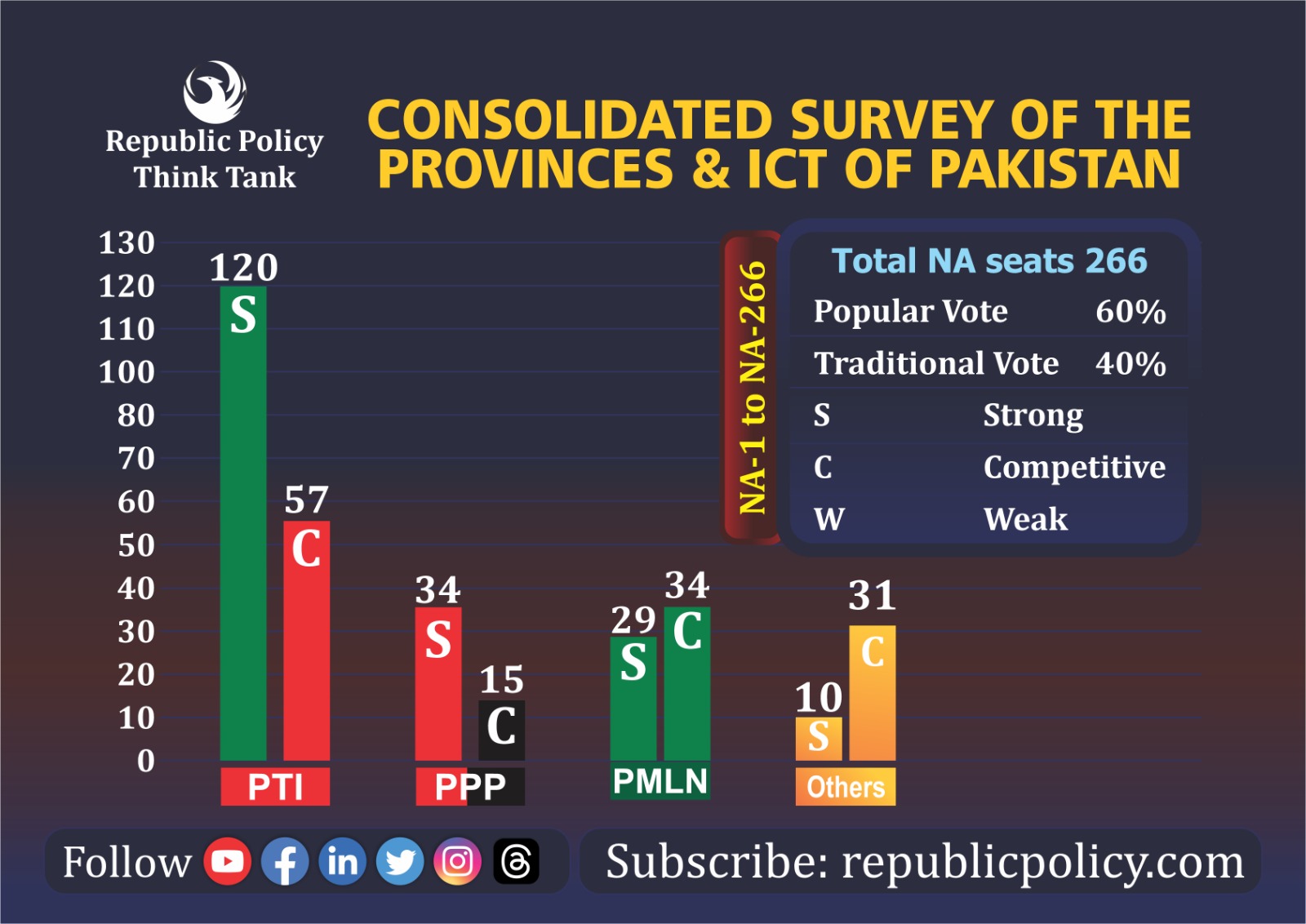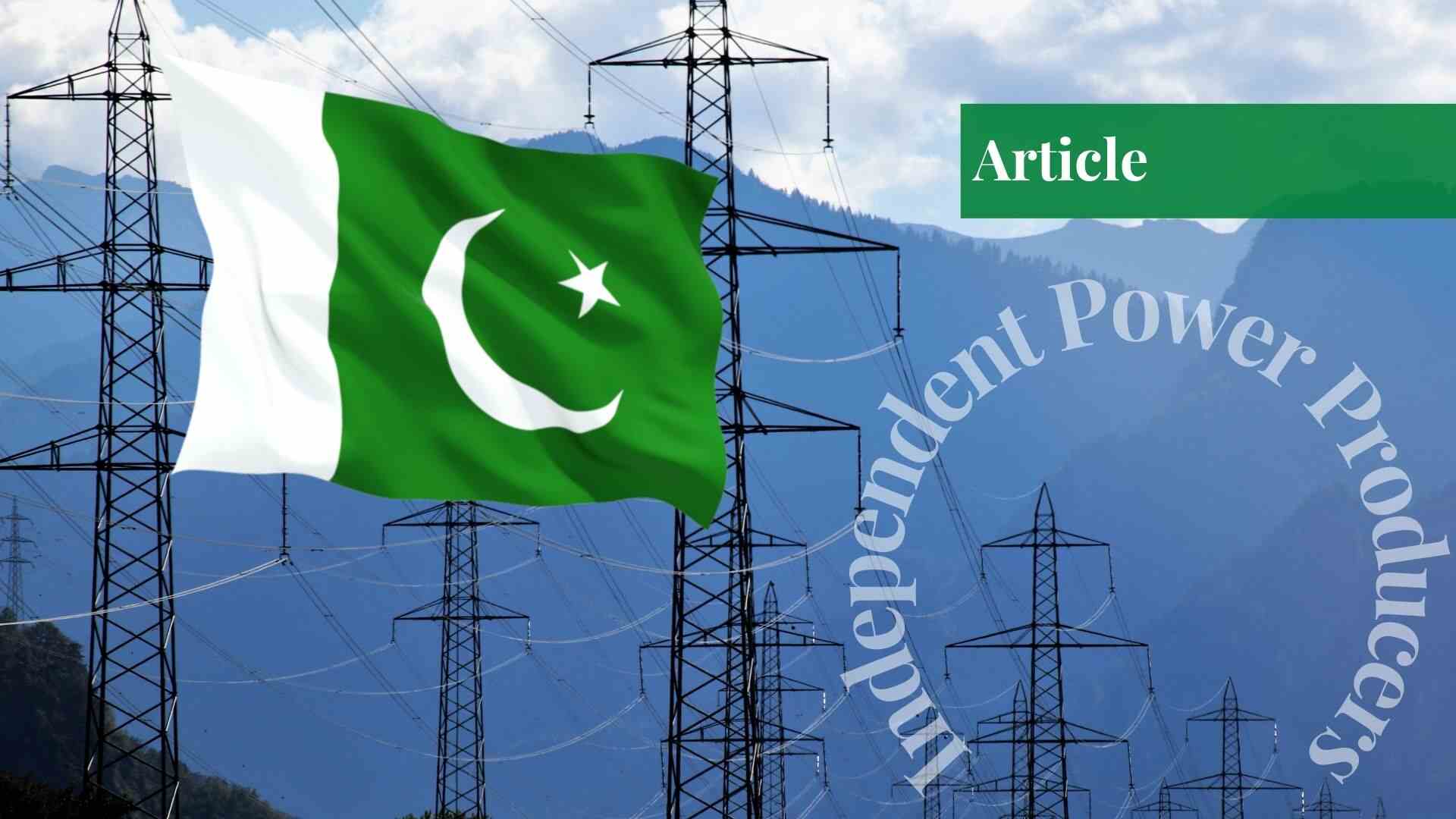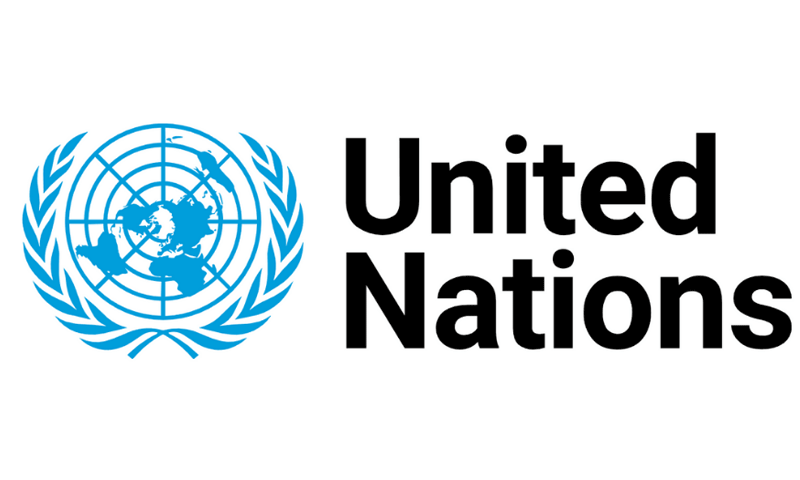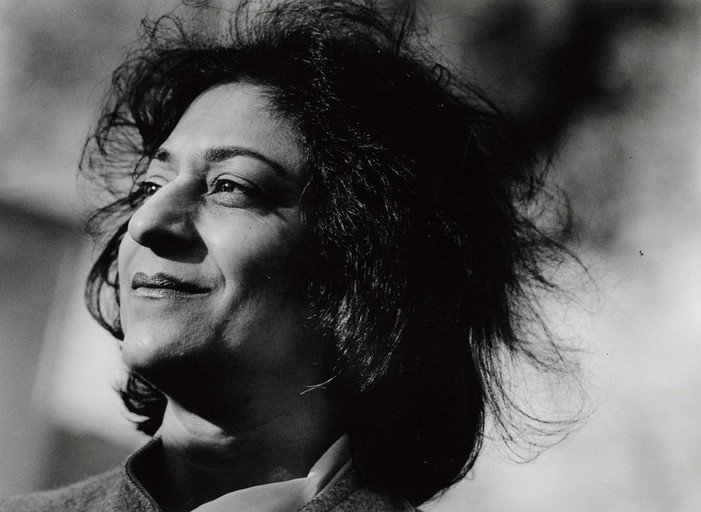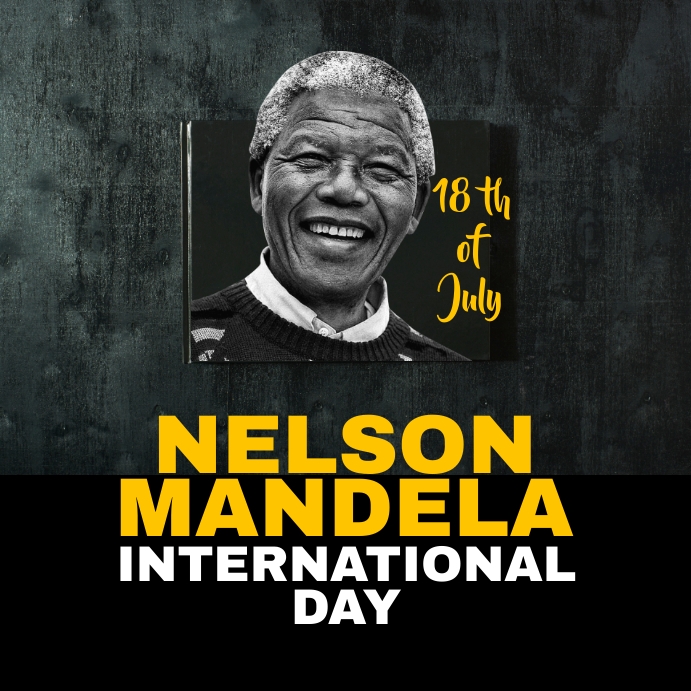Tahir Masood Chheena, Mubashir Nadeem, Abdul Latif Tahir, Hafeez Ahmed Khan, Naveed Baloch and Yasir Chandia
Pakistan is a Federal Republic according to Article 1 of the Constitution of Pakistan. Therefore, the government will be formed by the people’s chosen representatives. Then, Pakistan has a parliamentary form of governance. The parliament of Pakistan is bicameral. It consists of the National Assembly, Senate and the president of Pakistan. Article 52 of the Constitution of Pakistan provides five years as the term of the national assembly. According to Article 224, the Election Commission of Pakistan is responsible for conducting free and transparent elections. The Election Commission of Pakistan has announced the election for both national and provincial assemblies on 8 February 2024.
As elections are around the corner, therefore, it is essential to measure the political trends. As an organization, Republic Policy often conducts different types of polls, surveys and voting to know and measure political trends. Accordingly, Republic Policy has conducted a constituency-based survey of National Assembly seats in Pakistan. It is critical to know that it is a constituency politics in Pakistan. Therefore, the primary Survey can only determine who wins how many constituencies. The other derivative measurements are presidential, like a popular leader or party, which might not be central to constituency politics.
A constituency-based election survey is a type of Survey that collects data on the opinions and preferences of voters in a specific electoral district or constituency. Such surveys are conducted to comprehend the political behaviour and attitudes of the electorate, as well as to predict the outcome of an election based on various factors.
Election-based surveys are conducted for various reasons, such as to measure the level of support and satisfaction for different political parties, candidates, and policies among the voters and to identify the key issues and concerns that influence the voting decisions of the voters.
Furthermore, they are conducted to assess the impact of demographic, social, and economic factors on the voters’ voting behaviour alongside evaluating the effectiveness of campaign strategies and communication methods used by the political actors. Then, providing feedback and guidance for the political actors to improve their performance and appeal to the voters is also critical. Surveys are meant to collect data so that policy derivatives may be developed. A survey is always dependent upon the questionnaire and the methodology of the Survey. A survey can only be evaluated through its methodology.
Election-based surveys can be conducted using different methods, such as:
Face-to-face interviews: This method involves interviewing a representative sample of voters in person, using a structured or semi-structured questionnaire. This method can provide rich and detailed data, but it can also be costly and time-consuming.
Telephone interviews: This method involves calling a random or selected sample of voters and asking them questions over the phone. This method can be faster and cheaper than face-to-face interviews, but it can also suffer from low response rates and potential biases.
Online surveys: This method involves sending an electronic questionnaire to a panel or a list of voters who have agreed to participate in online surveys. This method can be convenient and flexible, but it can also have issues with sampling quality and validity.
Mail surveys: This method involves mailing a paper questionnaire to a sample of voters and asking them to return it by post. This method can be simple and inexpensive, but it can also have low response rates and delays in data collection.
Election-based surveys can provide valuable insights into the political landscape and dynamics of a constituency, as well as help the political actors tailor their messages and actions to the needs and preferences of the voters. However, election-based surveys also have some limitations, such as:
Sampling errors: This refers to the possibility that the sample of voters surveyed may not accurately represent the population of voters in the constituency. This can affect the reliability and generalizability of the survey results.
Measurement errors: This refers to the possibility that the questions asked in the Survey may not capture the true opinions and preferences of the voters. This can affect the validity and accuracy of the survey results.
Response errors: This refers to the possibility that the respondents may not answer the survey questions honestly or consistently. This can affect the quality and credibility of the survey results.
Therefore, election-based surveys should be designed and conducted carefully, using appropriate methods and techniques, to ensure that they produce reliable and valid data that can inform and improve the political process. Accordingly, Republic Policy has conducted a constituency-based survey of Pakistan’s national assembly constituencies. Earlier, Republic Policy introduced constituency-based surveys in Pakistan. Therefore, primary data has been collected constituency-wise. Furthermore, constituencies are divided among union councils. The basic unit of the Survey is the union council. The duration of the Survey is from 1 October 2023 to 15 December 2023. The union councils are the political measurement of the local government departments, whereas the Election Commission of Pakistan divides the constituencies among populations. A delimitation of 2022 is used to collect data for the Survey.
Methodology of the Survey:
It is very important to understand the methodology of the Survey. The first part is that it is a constituency-based survey. The constituencies from NA-01 to NA-266 are distributed for data collection, with the Union Council as the basic unit in Punjab and KPK. Furthermore, the Survey methodology in Sindh and Baluchistan is different. That will be shared when surveys of Sindh and Baluchistan will be published.
The questionnaire is one:
Which political party will you vote for in the coming general elections?
The data in line with the questionnaire is further taken from two sources.
- Data is collected from the common voters from each UC comprising of an NA constituency.
- Data is collected from different representative communities in the NA constituency.
Thus, data is compiled accordingly. Then, the primary data is measured with five feedbacks to measure the political trend of the constituency.
The five pieces of feedback are the following:
- Who is the most popular political leader?
- Who is the most popular political party?
- Who is the most favourite candidate of the constituency?
- What is the first preference to vote?
- Who is the second-most favourite leader, party or candidate to vote?
There are two types of vote in Pakistan. First is popular vote and the second is traditional vote. The popular vote is a vote of political wave and remains uninfluenced by the considerations of baradari, Dhara, clans, castes and other affiliations. It is a vote of free will and prefers political parties, good governance, performance, and ideology. Whereas, the traditional vote is influenced by Baradari, Dhara, clans and electable. Therefore, the questionnaire, To which political party, will you vote in the coming general elections is directly dependent upon the popular vote.
- KPK: Republic Policy Consolidated Survey
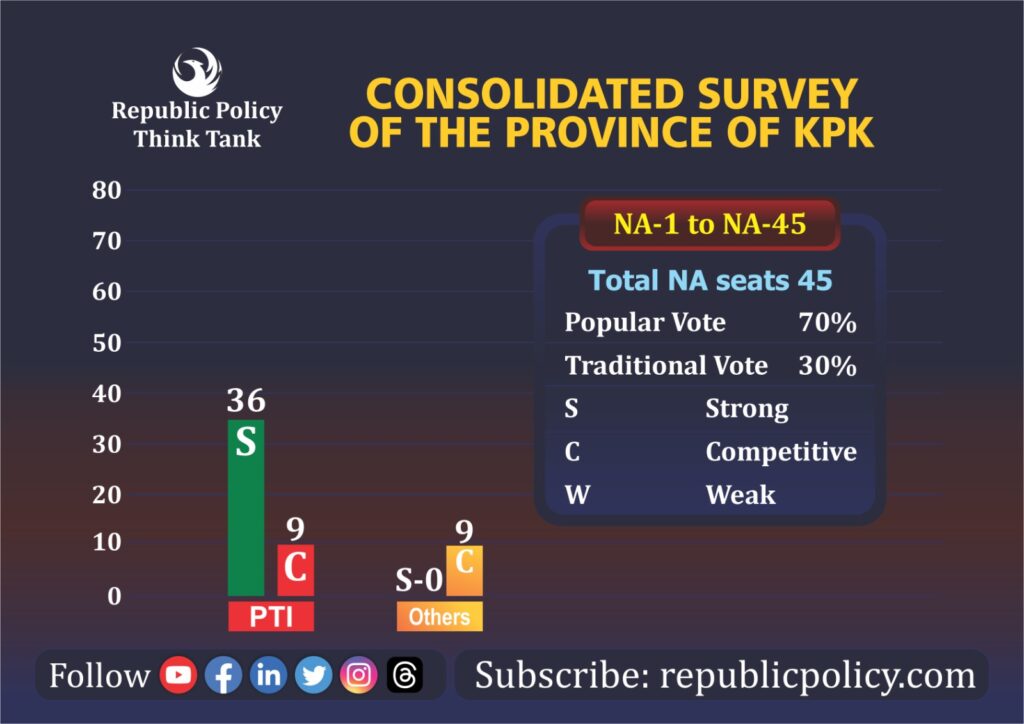
Republic Policy’s survey unveils fascinating insights into the political trends of Khyber Pakhtunkhwa (KPK), Pakistan’s third-largest province. With the 2024 general elections nearing, understanding the sentiments of this vibrant political hub is crucial.
Khyber Pakhtunkhwa (KPK) is a province of Pakistan that covers an area of 101,741 square kilometers and has a population of about 40.8 million people. It is bordered by Afghanistan to the west, Gilgit-Baltistan and Azad Kashmir to the north and east, Punjab to the southeast, and Balochistan to the south. The province has a diverse landscape, culture, and ethnicity, with Pashtuns being the dominant group, followed by Hindkowans, Saraikis, and Chitralis. The province’s official languages are Urdu and English, while the provincial language is Pashto.
The province has a history of political instability, violence, and militancy due to its strategic location near the Khyber Pass, which has been a gateway for invasions and migrations throughout history. The province was also affected by the Afghan wars, the Taliban insurgency, and the US-led war on terror, which resulted in many casualties, displacements, and human rights violations. The province has also faced challenges of poverty, illiteracy, corruption, and underdevelopment.
The province has a unicameral legislature, the Khyber Pakhtunkhwa Assembly, with 145 elected members, including 115 general seats, 26 seats reserved for women, and 4 seats for non-Muslims. The provincial government is headed by the Chief Minister, who is elected by the Assembly and appoints a Cabinet of Ministers. The Pakistani president appoints the governor of the province and acts as the representative of the federal government. The province also has a High Court, which is the highest judicial authority in the province. Furthermore, the province of KPK has 45 seats in the National Assembly.
The province has a multiparty system, with several political parties competing for power and influence. The main parties are:
- Pakistan Tehreek-e-Insaf (PTI): This has been the ruling party in the province since 2013, led by Imran Khan, the former Prime Minister of Pakistan. PTI is a centrist, populist, and reformist party that advocates for anti-corruption, good governance, social justice, and Islamic democracy. PTI has a strong support base among the urban, educated, and youth segments of the population, as well as among the Pashtuns of the province. PTI has also implemented several development and welfare projects in the province, such as the Billion Tree Tsunami, the Sehat Insaf Card, and the Khyber Pakhtunkhwa Police Act.
- Jamiat Ulema-e-Islam (F) (JUI-F): This is the main opposition party in the province, led by Maulana Fazlur Rehman, a religious scholar and politician. JUI-F is a conservative, Islamist, and nationalist party that follows the Deobandi school of thought and advocates for the implementation of Sharia law, the protection of the rights of the religious minorities, and the resistance against foreign interference . JUI-F has a strong support base among the rural, religious, and tribal segments of the population, especially in the southern and western parts of the province . JUI-F has also been involved in various movements and protests against the PTI government, such as the Azadi March and the Pakistan Democratic Movement PDM.
- Awami National Party (ANP): This is a regional, secular, and nationalist party that represents the interests of the Pashtuns of the province, led by Asfandyar Wali Khan, the grandson of the legendary Pashtun leader Khan Abdul Ghaffar Khan. ANP is a socialist, progressive, and democratic party that advocates for the rights of the ethnic minorities, the promotion of Pashtun culture and language, and the peaceful resolution of the conflicts in the region . ANP has a strong support base among the Pashtuns of the central and northern parts of the province, especially in the Peshawar Valley . ANP has also suffered from many attacks and assassinations by the Taliban and other militant groups, due to its secular and anti-Taliban stance.
Other parties that have some presence and influence in the province are:
- Pakistan Muslim League (N) (PML-N): This is a centre-right, conservative, and nationalist party led by Nawaz Sharif, the former Prime Minister of Pakistan. PML-N is a pro-business, pro-development, and pro-establishment party that advocates for the strengthening of the federation, the rule of law, and civilian supremacy (However, according to critics, PMLN has abandoned their values lately being in power). PML-N has a strong support base in the Punjab province, but it also has some pockets of support in the Hazara region of KPK, where it appeals to the non-Pashtun communities, such as the Awans, the Abbasis, the Gujjars, and the Jadoons.
- Pakistan Peoples Party (PPP): This is a centre-left, liberal, and progressive party that is the third-largest party at the national level, led by Bilawal Bhutto Zardari, the son of the late Benazir Bhutto, the former Prime Minister of Pakistan. PPP is a populist, socialist, and secular party that advocates for the empowerment of the masses, the protection of the human rights, and the reconciliation of the diverse groups . PPP has a strong support base in the Sindh province, but it also has some pockets of support in the Malakand division of KPK, where it appeals to the lower and middle classes, especially in the districts of Swat, Shangla, and Buner .
- Jamaat-e-Islami (JI): This is an Islamist, democratic, and reformist party that has been a coalition partner of the PTI government at the provincial level, led by Siraj ul Haq, a former Chief Minister of KPK. JI is a moderate, rational, and pragmatic party that follows the Maududi school of thought and advocates for establishing an Islamic welfare state, reviving Islamic values, and promoting Islamic unity. JI has a strong support base among the urban, educated, and religious segments of the population, especially in the Malakand division of KPK, where it has a strong organizational network and social services.
The methodology and other patterns of the survey have been published at republicpolicy.com
This is an overview of the political trends of the province of KPK.
Imran Khan Takes the Lead: The survey crowns Imran Khan the undisputed king of KPK’s hearts. His popularity soars across the province, fueled by PTI’s consistent electoral victories in the past two terms.
Beyond the Leader: But KPK’s political tapestry is intricately woven with diverse regional dynamics.
- Malakand Division: This vast and unique region, with ten districts, shows PTI as the dominant force, followed by Jamaat-e-Islami (JI). Imran Khan reigns supreme here, with Siraj ul Haq of JI a distant second. PML-N struggles for a foothold, though local electables hold pockets of influence.
- Hazara Region: This non-Pashtun belt exhibits a fascinating shift. Traditionally PML-N’s stronghold, it has now succumbed to PTI’s charm. Khan enjoys immense popularity, followed by the PML-N family leaders. Electables, particularly tribal chiefs representing various communities, remain significant players.
- Peshawar Valley: The historical power base of Awami National Party (ANP) and nationalists has witnessed a seismic change. PTI and Khan rule the roost, leaving ANP and the Sherpao family far behind. Jamiat Ulema-e-Islam (JUI-F) holds sway in specific pockets, but the overall trend is undeniably pro-PTI.
- South KPK: This region presents a different picture. While Khan and PTI remain comfortably ahead, Maulana Fazal ur Rehman and JUI-F enjoy considerable support. The region, comprising Kohat and Dera Ismael Khan divisions, once belonged to JUI-F, but PTI has steadily gained ground. However, JUI-F remains competitive on several seats.
- Ex-FATA: This newly merged region exhibits a unique political landscape. Local tribal leaders command significant influence. PTM, though not a registered party, finds support in Waziristan. Bajaur leans towards PTI, while other areas have prominent electables and JUI-F pockets. Notably, Khan and PTI maintain their lead over all other parties, but chieftains remain critical players in securing victories.
The Nuances of Electoral Success: The survey goes beyond mere popularity, emphasizing the importance of strong candidates and the right combinations of party and individual in each constituency. Winning Ex-FATA, for instance, requires both a popular party like PTI and a strong local candidate aligned with tribal leaders.
KPK’s political scene is a captivating blend of regional identities, tribal dynamics, and shifting loyalties. Republic Policy’s survey shines a light on these complexities, offering valuable insights for understanding the upcoming elections and the future of Pakistani politics in this vital province.
Who will win how many NA seats in KPK?
The upcoming National Assembly elections in Khyber Pakhtunkhwa (KPK) promise a captivating contest, with Pakistan Tehreek-e-Insaf (PTI) seemingly holding the upper hand due to a combination of popular support and strategic positioning. However, a closer look reveals a more nuanced picture, with other parties still vying for a foothold in the 45 NA seats.
The Power of Popularity:
The Republic Policy Organization survey highlights a critical factor: a 70/30 split between popular and traditional vote. This signifies that public opinion plays a substantial role in swaying voters in KPK. PTI seems to have capitalized on this trend, emerging “strong” in 36 NA seats, translating to a potential two-thirds majority. This dominance likely stems from their anti-corruption narrative, focus on youth issues, and effective use of social media to connect with voters directly.
Unveiling the “Competitive” Battleground:
While PTI’s stronghold appears substantial, the remaining 9 “competitive” seats offer an opportunity for other players. Here, traditional loyalties and local issues might come into play. Parties like PMLN, ANP, and JUIF might leverage their established networks and historical ties to sway voters. This scenario creates a “swing district” dynamic, where the focus will be on mobilizing ground support and addressing local concerns effectively.
Beyond the PTI Juggernaut:
Though seemingly overshadowed by PTI’s popularity, other parties cannot be discounted. PMLN, despite facing national challenges, still holds historical influence in certain areas of KPK. ANP, known for its Pashtun nationalist ideology, enjoys strong support in specific regions. JUIF, with its religious base, remains relevant in rural areas. While these parties might not directly challenge PTI’s dominance, they can influence outcomes in close races through strategic alliances or by splitting the “competitive” vote bank.
The Traditional Vote: A Wildcard?:
The 30% traditional vote segment adds another layer of complexity. Though the survey suggests PTI has largely consolidated this segment, traditional affiliations and tribal dynamics can sometimes override broader trends. Localized grievances and personal connections with candidates might sway voters in unexpected ways, particularly in rural areas.
Predicting the final outcome in KPK remains challenging. While PTI has a clear advantage, the “competitive” seats hold the potential for surprises. Effective campaigning, addressing local concerns, and mobilizing traditional networks will be crucial for all parties aiming to secure victory. Additionally, external factors like national political developments and security concerns can also influence voter behaviour.
2. Islamabad: Republic Policy Consolidated Survey
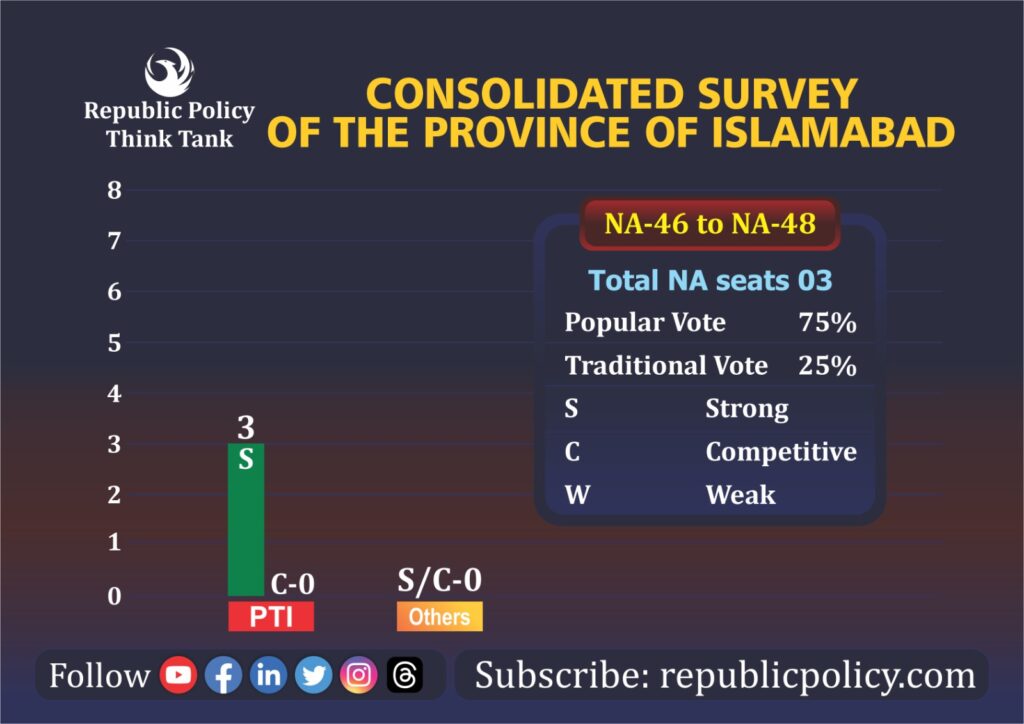
Pakistan is a Federal Republic according to Article 1 of the Constitution of Pakistan. Therefore, the government will be formed by the people’s chosen representatives. Then, Pakistan has a parliamentary form of governance. The parliament of Pakistan is bicameral. It consists of the National Assembly, Senate and the president of Pakistan. Article 52 of the Constitution of Pakistan provides five years as the term of the national assembly. According to Article 224, the Election Commission of Pakistan is responsible for conducting free and transparent elections. The Election Commission of Pakistan has announced the election date in January 2024 for both National and Provincial assemblies.
The Survey of Islam Abad:
From 1977 to 1997, Islamabad had one NA Constituency, NA-35 Islamabad. From 2002 to 2013, Islamabad had 2 National Assembly constituencies, NA-48 Islamabad-I and NA-49 Islamabad-II. In 2018, Islamabad had 3 National Assembly Constituencies: NA-52 Islamabad-I, NA-53 Islamabad-II, NA-54 Islamabad-III. Presently, according to the delimitation of 2022, Islam Abad has three NA constituencies, numbering NA-46 to NA 48. The survey of the Republic Policy is based on delimitation 2022. However, a new delimitation process of constituencies is being carried out, and it will not affect the constituencies.
Islamabad Capital Territory includes urban and rural areas. The rural area consists of 23 union councils, comprising 133 villages, while the urban has 27 union councils. It is important to know the political dimensions. It is basically a rural and urban divide. Even the sectors contain old villages. However, the urbanite culture has started to dominate the Islam Abad. Then, Punjabis and Pashtun are in the majority over Sindhis or Balochis. In urban Islamabad, PTI leads by a significant margin. In villages or remote areas of Islam Abad, there is still a birdadri or dharara system, which is also important. Gujjars, Khokhars, Awans, Rajas, Abbasis are in prominent Briadries of Islam Abad. Yet, political parties are also popular in the rural areas. PTI and PMLN are strong in the rural areas of Islamabad. Then, ethnically, Pashtun has a strong affiliation towards PTI. Punjabis who settle here are also comparatively prone to PTI. Therefore, the political dynamics of Islamabad have to be dissected, covering multiple factors. Likewise, NA 46 is a city constituency, and it is different to other constituencies; NA-47 is a mixed bag of urban and rural areas, while NA-48 is comparatively more rural. Urban areas have different political trends as compared to rural areas. However, both areas have one thing in common now: Political parties are more critical than candidates or other affiliations.
Some of the factors that could shape the political landscape of Islam Abad in 2023-24 are:
Performance: The performance of the federal and provincial governments, led by PTI and later by PDM, will be a major factor in influencing the voters’ preferences and perceptions. PTI came to power in 2018 with a promise of change and reform but has faced many challenges and criticisms in delivering its agenda. The issues of inflation, unemployment, corruption, governance, security, and foreign policy might have been crucial in determining public satisfaction and trust in PTI. However, the regime change has entirely changed the perception of the people. Now, the incumbency factor is with PMLN, which has been criticized for inflation and ineffective governance. On the other hand, PML-N is now trying to highlight its achievements and projects during its previous tenure, especially in Punjab and Lahore, where it implemented many development and infrastructure schemes. The performance of the interim government, which was formed in August 2023 to oversee the election process, will also be important in ensuring a fair and transparent election.
Campaign: The campaign strategies and tactics of both parties will be another factor in shaping the political landscape of Islamabad in 2023. Both parties will try to mobilize their supporters and attract new voters through rallies, processions, advertisements, social media, door-to-door visits, etc. The campaign will also involve alliances and coalitions with other parties and groups, such as the Sunni Ittehad Council and Majlis Wahdat-e-Muslimeen (MWM), which are supporting PTI in some constituencies. The campaign will also involve personal attacks and accusations between the leaders and candidates of both parties, as well as appeals to the emotions and sentiments of the voters. However, presently, it seems that PTI is not finding the appropriate opportunities to do the election campaigns. However, election campaigns are critical for winning constituencies.
Turnout & Polling Day Management: The turnout of the voters will be a decisive factor in determining the outcome of the election. According to the Election Commission of Pakistan (ECP), the general elections are scheduled to take place in the final week of January 2024. The weather conditions, security situation, public awareness, and motivation will affect the turnout of the voters. Generally, a higher turnout is expected to favour PTI, as it has a loyal and committed vote bank in Islamabad. A lower turnout is expected to favour PMLN, as it has a more traditional and orthodox voter base. However, there could be surprises and variations depending on the local dynamics and circumstances of each constituency.
Findings of the Republic Policy Survey:
PTI is the popular party in urban and rural areas. In urban areas, it is dominating and in rural areas, it is leading. The educated and urban class is with PTI despite having different ethnicities, languages or cultures. The urban and rural Islamabad’s middle and upper middle class is with PTI. PMLN is strong in rural areas, with the help of traditional candidates and bridaries.
The youth is predominately with PTI. Whether in fashionable communities or conservative, the youth have a better tilt towards PTI. The Republic Policy team have visited several colleges and universities, and almost the majority of students are with PTI, irrespective of gender. Republic Policy has also taken feedback from different communities of professions. The professionals, public servants, teachers and other white-collar employees are mostly with PTI. Still, PMLN has a reasonable presence among traders. However, the presence is comparatively less due to inflation caused by the PDM government.
Even in Islamabad, most people will still vote for inflation. Then, an educated class is tilted towards voting for democracy, the rule of law and justice. The caste system is not as strong as it is in other districts. Still, they will influence marginally on a few constituencies in the rural parts of Islamabad.
Islamabad’s affiliation with political parties is solid, unlike other districts. Mostly, the role of political party will be decisive. Then, the candidate’s electability is essential, but only a little. Polling management is always crucial. However, all 03 NA constituencies will compete between PTI and PMLN.
As per the survey data, up to 80 per cent of voters intend to cast votes for the political parties. In Islamabad, the symbol of political parties will be the decisive factor. Therefore, independent or other candidates may need help to contest the elections. However, Khokhars have some influence in one of the NA constituencies due to their dhara. However, they may need more than that to win the constituency with the support of either PTI or PMLN. Then, in the rural areas, there are some personal votes.
Therefore, mediocre candidates with the symbols of PMLN and PTI stand better chances to win the NA constituencies. Accordingly, PTI has a strong case in Islamabad if they are printed on the ballots in the constituencies.
According to the data of 50 union councils, Imran Khan is the most popular leader, followed by the leaders of PMLN. There is a sympathy wave for Imran Khan, and it is the primary reason for his popularity. Nawaz Sharif is the only popular leader of PMLN. Shahbaz Sharif and Maryam Nawaz Sharif do not have the approval rate of the voters, even among the PMLN supporters. Saad Rizvi is the third most popular leader in Islamabad. Imran Khan is popular among the youth and educated class of Islamabad. The Republic Policy team visited a college for data collection. When opinion was sorted out in a classroom, there were 50 students there, and almost 45 of them approved of Imran Khan over all other leaders. This is the level of Imran Khans’ popularity among educated youth in Islamabad.
A political leader must remain popular among the common masses. Imran Khan is the only leader with a popular support base among all categories of voters. Muhammad Nawaz Sharif is popular primarily among the PMLN workers, voters and supporters. He needs the popular support of the voters. Then, the vote bank of PMLN is due to Muhammad Nawaz Sharif. Other PMLN leaders are not so much popular among PMLN supporters, especially Shehbaz Sharif, who is blamed for the falling popularity of PMLN after his performance as PM of Pakistan during the PDM government.
Vote categorization is significant to understand the methodology of the survey. It is the inflation which is the primary cause of voting in Islamabad also. Especially among lower middle class and poor communities, inflation is the direct drive to cast a vote. Pro-democracy votes follow it in the urban part of Islamabad. Among educated communities, there is more urge for the rule of law, democracy, participation, the right to elect governments and implementation of fundamental rights. Accordingly, their primary drive is to vote for those political parties which could uphold the spirit of democracy and the rule of law. Biradri/Dhara is less effective in Islamabad than in other parts of Pakistan. Religious/Ethnic affiliations are also there, but the core voting pattern is inflation and pro-democracy vote. Then, both these factors were once with PMLN at the beginning of 2022 and before the regime change. However, now both these factors are with PTI.
The problem with PMLN is now the voting flow obstruction. PMLN only enjoys the support of workers and supporters. The impartial voter is not with them. Then, to win an NA constituency in Islamabad requires more than one lac votes, and it will only happen once common voters turn up to vote. The other problem with PMLN is that they are unable to woo new and young voters. The new voters will play a significant role, and most are tilting towards PTI, which seems a more fashionable choice than PMLN, which is doing the politics of the status quo.
Voters also believe that the caretaker government may be doing well compared to PDM in the field of economy and inflation. In this scenario, if the caretaker government performs reasonably well, the graph of PMLN will further recede. Furthermore, PMLN is trying to convince their voters that the era of Nawaz Sharif was good for the country, and if they are again voted in, PMLN under Nawaz Sharif will perform like they had been doing before. However, the voters in Islamabad are evaluating the performance of PMLN on the performance of the PDM government and their slogan of” vote ko Izzat do”.
The primary question of the survey is, whom will you vote for if elections are held today? The survey is primarily conducted to measure the popularity of the political parties in the constituencies. PTI is the most popular political party, followed by PMLN. TLP also has a vote bank of the Brelvi sect. Then, there are a few pockets of JI, PPPP and others, mainly the candidates.
There are two primary reasons for PTI’s popularity. One is they are without an incumbency factor, and the other is the sympathy wave. Most of the people feel that PTI is not being treated as per law. Furthermore, most voters also believe it is their right to elect governments. This awareness is far more substantial in Islamabad than in other parts of Pakistan.
A political party must garner popular support. PTI is riding on the popular support because they do not have the incumbency factor. The burden of incumbency is on PMLN, which has performed miserably in the PDM government, according to the data collected by republicpolicy.com. Of course, it is constituency politics in Pakistan due to the parliamentary form of governance; however, popular party and leader support also matter. PMLN will manage NA constituencies through local government representatives, party organizers, workers and strong candidates, but they will find the ultimate challenge of needing more widespread support. On the other side, PTI has massive popular support in most of the constituencies in Islamabad, and they can win constituencies even if they place mediocre candidates and put in mediocre election campaigns. However, polling day management will be crucial for both parties.
The Survey Results:
After collecting data through a sample size of each Union Council within the National Assembly Constituency and measuring that with five feedbacks, the survey results of the survey of Republic Policy show that PTI is leading all three NA seats in Islamabad, followed by none. PTI is leading NA- 46 with a substantial margin. It also leads comfortably to the NA 47 and has a lead in the NA-48.
3. Punjab: Republic Policy Consolidated Survey
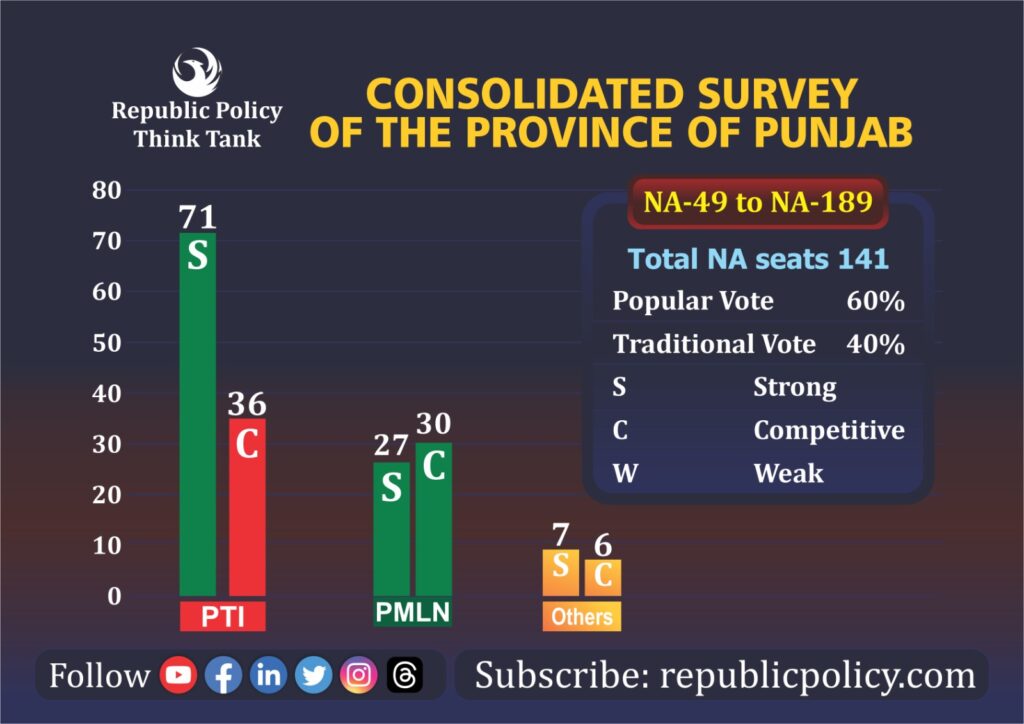
In October and November 2023, Republic Policy conducted a survey of 141 national assembly constituencies of Punjab, which is the most populous and politically significant province of Pakistan. Punjab has a population of over 110 million people, which accounts for more than half of the total population of Pakistan. Punjab is also the largest contributor to the national economy, with a GDP of over $200 billion, which is about 55 per cent of Pakistan’s total GDP. Punjab is also the home of the country’s political elite, as most of the prime ministers and presidents of Pakistan have been from Punjab. Punjab has a history of being a stronghold of the Pakistan Muslim League-Nawaz (PMLN), which was in power in the last PDM government. The survey aimed to gauge the voting preferences and opinions of the people of Punjab ahead of the general elections scheduled to be held on February 8, 2024. The general elections are expected to be a close contest between the Pakistan Tehreek-e-Insaf (PTI) and the PMLN in the province of Punjab, as well as other smaller parties and independent candidates.
The survey used the Union Council (UC), which is the lowest tier of local government in Pakistan, as the survey unit. A union council consists of a few elected members, including a chairman, a vice-chairman, and a few councillors according to the local government acts in Punjab. It is pertinent to mention that the local government is not an established government in the province of Punjab. The union council is responsible for providing basic services and facilities to the people in its jurisdiction, such as water, sanitation, health, education, and security. The union council also plays a role in the electoral process, as it is the smallest unit of electoral representation and administration. The survey covered 41 Punjab districts, divided into 297 provincial assembly seats and 141 national assembly seats. The provincial assembly is the legislative body of the province, which makes laws and policies for provincial matters, such as health, education, agriculture, and local government. The national assembly is the lower house of the parliament, which makes laws and policies for the federal matters, such as defense, foreign affairs, finance, and taxation.
The survey asked the respondents a single question: Which party will you vote for in the coming general elections?
The survey reached out to voters of all age brackets, ranging from 18 to 65 plus, at the UC level in each NA constituency. The survey also ensured that the respondents were proportionally representative of the male and female population of Punjab, as well as the different occupations and sectors of the society, such as traders, farmers, professionals, students, laborers, and others. The survey also asked the respondents about their favorite leader, favorite candidate, the performance of the political parties, the manifestos of the political parties, and the local dynamics of the constituencies. The survey used a random sampling technique to select the respondents, and used face-to-face interviews to collect the data. The survey also used a margin of error of 10 percent and a confidence level of 90 percent to ensure the reliability and validity of the data.
The survey collected and analyzed the data from the constituencies at the UC level and synthesized it with the feedbacks from the respondents. The survey found that the Pakistan Tehreek-e-Insaf (PTI) was the most popular political party in Punjab, with 60 percent of the respondents expressing their support for it. The PTI came to power in the 2018 general elections, with the slogan of “Naya Pakistan” (New Pakistan), promising to bring change and reform in the country. However, in 2022, their government was outnumbered by the PDM political parties through a vote of no confidence. The PTI claims to have delivered on its promises, such as improving the economy, fighting corruption, providing social welfare, and strengthening foreign policy. The Pakistan Muslim League-Nawaz (PMLN) was the second most popular party, with 25 per cent of the respondents favouring it. The PMLN was the main political party in the federal government, led by a coalition led by PDM. However, they were the opposition party in the provincial assembly of Punjab, and furthermore, it is led by Shehbaz Sharif, the younger brother of former Prime Minister Nawaz Sharif. The PMLN was also in power from 2013 to 2018, and claims to have brought development and prosperity to the country, especially in Punjab. The remaining 15 percent of the respondents were divided among other political parties, such as the Pakistan Peoples Party (PPP), the Tehreek-e-Labbaik Pakistan (TLP), and the Jamaat-e-Islami (JI). The PPP was the third largest party in the federal parliament and the ruling party in the province of Sindh, and is led by Bilawal Bhutto Zardari, the son of former Prime Minister Benazir Bhutto. The PPP has a history of being a progressive and populist party, with a strong base in rural Sindh and parts of Punjab. The PPP also claims to be the champion of democracy and federalism. The PPP also faces several challenges, such as the corruption allegations and cases against its leaders, the poor governance and performance in Sindh, and the loss of support and relevance in the province of Punjab. The TLP is a religious party that emerged in 2017 and was led by the late Khadim Hussain Rizvi, a firebrand cleric who advocated for the strict enforcement of the blasphemy laws and the protection of the honour of Prophet Muhammad (PBUH). The TLP has a loyal and passionate following among the religious and conservative segments of society, especially in the rural areas of Punjab. The TLP also has a history of staging massive and violent protests against the government and the judiciary, demanding the implementation of its agenda. The TLP also faces several challenges, such as the ban imposed by the government on its activities, the arrest and detention of its leaders and workers, and the lack of a clear political and economic vision for the country. The JI is an Islamic party that has been active in Pakistan since 1947, and is led by Sirajul Haq, a veteran politician and scholar who advocates for the establishment of an Islamic system of governance and society in Pakistan. The JI has a well-organized and disciplined structure and network, with a presence in all provinces and regions of Pakistan. The JI also has a reputation of being a principled and ideological party, with a focus on moral and ethical issues, such as corruption, justice, and human rights. The JI also faces several challenges, such as the low and stagnant electoral support, the competition and conflict with other religious parties, and the lack of appeal and relevance among the youth and the mainstream segments of the society.
The survey concluded that the PTI had a clear lead over its rivals in Punjab and had a better chance to win the elections if it worked on three factors: the selection of candidates in the constituencies, the election campaign, and the polling day management. The survey suggested that the PTI should select candidates who are popular, credible, and loyal to the party, and avoid any controversies or conflicts within the party ranks. The survey also suggested that the PTI should run an effective and aggressive election campaign, highlighting its achievements and promises, and exposing the failures and flaws of its opponents. The survey also suggested that the PTI should ensure a smooth and fair polling day management, mobilizing its voters and workers, and preventing any rigging or violence. The survey also suggested that the PMLN and other parties had to work hard to regain the trust and support of the people of Punjab, who were dissatisfied with their performance and policies. The survey suggested that the PMLN should resolve its internal and external ideological narratives, such as Vote ko Izzat Do, and also defect from the poor PDM government, which brought poor governance and inflation. The survey also suggested that the PMLN should run a positive and persuasive election campaign, focusing on PTI’s strengths and weaknesses.
Who wins how many NA seats in Punjab?
The upcoming elections in Punjab are shaping up to be a nail-biting contest between the two leading contenders: Pakistan Tehreek-e-Insaf (PTI) and Pakistan Muslim League (N) (PMLN). The consolidated survey by the Republic Policy Organization paints a picture of a closely fought battle, with both parties vying for dominance in the province’s 141 National Assembly seats.
PTI’s Strong Position: The survey suggests that PTI currently holds a strong position in 71 constituencies, potentially giving them a solid base upon which to build. Additionally, they are considered competitive in 36 more seats, bringing their total potential winnable seats to 107. This represents a significant chunk of the available seats, showcasing PTI’s strong presence in the province. However, it depends on whether they are able to get cast their potential popular vote and also successfully cross the challenge of symbols.
PMLN’s Second Position: While PTI enjoys a seemingly advantageous position, PMLN should not be underestimated. The survey indicates their strength in 27 constituencies, demonstrating their hold on traditional strongholds. They are also competitive in 30 additional seats, offering them the potential to expand their reach. The fundamental challenge of PMLN is shrinking popular vote and therefore, their electoral success depends upon the traditional and electable voets.
Beyond the Two Main Political Parties: While the main focus remains on PTI and PMLN, other players cannot be ignored. The survey identifies seven seats where independent candidates, the PPP, and the IPP (Istahkam-e-Paksitan Party) are deemed strong contenders. These forces are also competitive in 6 NA seats and could potentially influence the outcome depending on their alliances and strategies.
Despite the survey offering insights, predicting the final results remains challenging. Two crucial factors will significantly impact the outcome:
- PTI’s Popularity: The survey acknowledges PTI’s strong popular vote, suggesting their appeal to a wider electorate. However, translating this popularity into electoral success requires effective mobilization, campaign strategies and, particularly, voting day management.
- PMLN’s Organizational Strength: PMLN, while facing recent challenges, boasts a strong organizational structure and deep roots in traditional vote banks. Their ability to mobilize these voters could prove decisive.
The upcoming elections in Punjab promise to be a fascinating contest. While PTI appears to have a slight edge on paper, PMLN’s organizational strength and traditional support base cannot be ignored. The outcome likely hinges on how each party capitalizes on its advantages and navigates the complex political landscape of Punjab. The presence of other players adds another layer of uncertainty, making the race even more unpredictable. Only time will tell who emerges victorious in this highly anticipated battle for political supremacy in Punjab.
Lastly, there is competition between PTI and PMLN in the Punjab province. However, the electives, under IPP, may be effective in southern Punjab or in those seats where the popular vote is less than the traditional vote. The political landscape of Punjab is dynamic and nuanced. While the survey provides valuable insights, predicting the final outcome remains complex. Both PTI and PMLN have their strengths and weaknesses. Ultimately, the party that effectively utilizes its resources, connects with the electorate and addresses key concerns will secure victory in the upcoming elections.
4. Sindh: Republic Policy Consolidated Survey
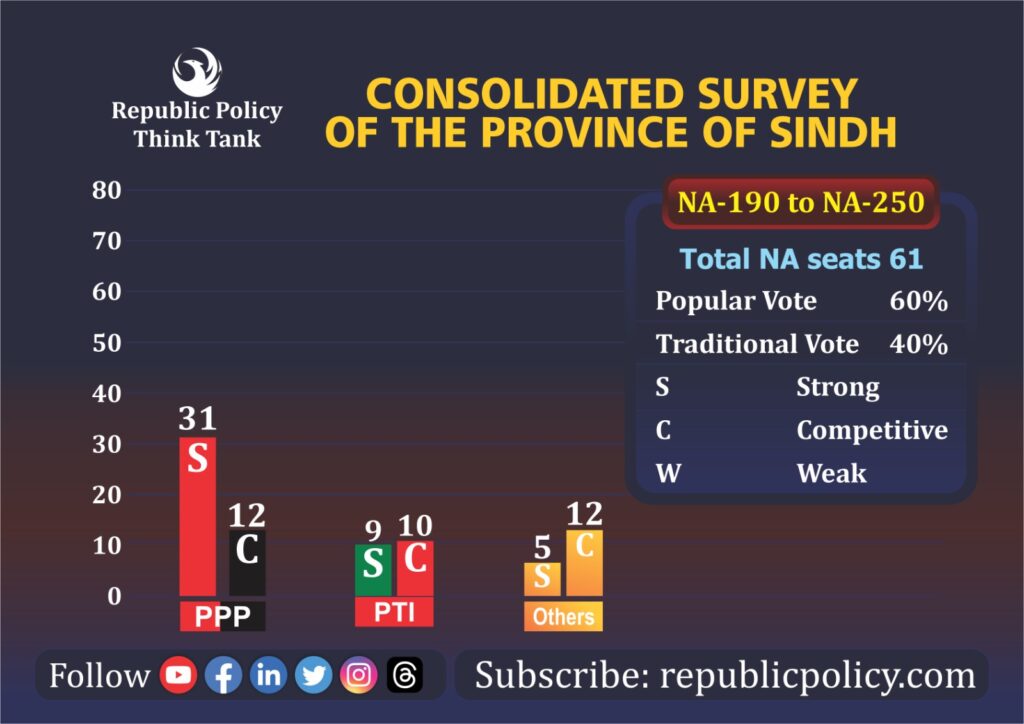
The upcoming National Assembly elections in Sindh promise a complex and fascinating battleground, with three main contenders vying for control of the province’s 61 NA seats. The Republic Policy Organization’s consolidated survey paints a picture of a fragmented political landscape, with no single party holding a clear majority, but also reveals some interesting trends.
The Dominance of PPP in Rural Sindh:
The survey paints a clear picture of the Pakistan People’s Party (PPP) as the undisputed champion in rural Sindh. Its grip on the Sindhi-speaking majority, coupled with reasonable support among the Pukhton, Punjabi, and non-Sindhi, including the Urdu-speaking minority, solidifies its position as the dominant force. This strength likely stems from a combination of factors, including historical ties, established political networks, and effective mobilization of traditional power structures within rural communities. Furthermore, they have been in power and influenced the Sindhi bureaucracy and other institutions.
GDA and Religious Parties: Divergent Paths in Rural Politics:
While the PPP reigns supreme, the Grand Democratic Alliance (GDA) and religious parties like Jamaat-e-Ulema-e-Islam (JUI) carve out their own niches. The GDA, a coalition of smaller parties, finds traction among the Peer Pagara sympathizers minority and disgruntled Sindhi electorate segments seeking an alternative to the PPP. JUI, on the other hand, draws its strength from its religious base and its focus on issues relevant to rural communities.
Urban Sindh: A Complex Tapestry of Political Forces:
The urban landscape of Sindh, particularly in cities like Karachi and Hyderabad, presents a much more intricate political tapestry. Here, the PPP faces a more diverse and competitive environment. The PTI, as the main opposition party in Karachi, has made inroads in urban areas, capitalizing on dissatisfaction with the incumbent government and its appeal to younger voters.
The MQM: A Shifting Landscape of Influence:
The Muttahida Qaumi Movement (MQM), once the dominant voice of Karachi’s Urdu-speaking community, has seen its influence wane in recent years. The ban on its founder, Altaf Hussain, has created a vacuum that other parties, like the PTI and Jamaat-e-Islami, are vying to fill. This shifting landscape injects further uncertainty into the urban political scene.
Karachi’s Unique Political Dynamics:
Karachi stands out for its unique composition, with Muhajir, Sindhi, Pashtun, Punjabi, and other groups vying for influence. The “wave vote,” a phenomenon where a single party enjoys overwhelming support across all districts, adds another layer of complexity. Analyzing Karachi’s political landscape requires careful consideration of these diverse demographics and the potential for sudden shifts in voting patterns.
The Post-Altaf Hussain Scenario:
The absence of Altaf Hussain has opened up new possibilities within Karachi’s Urdu-speaking community. While the MQM remains a significant force, the PTI and Jamaat-e-Islami have emerged as potential alternatives. The survey suggests that Sindhis and Urdu-speaking Sindhis tend to avoid cross-voting, creating distinct voting patterns within these communities. Furthermore, Karachi’s Pashtun population appears to be shifting its allegiance from the ANP towards the PTI.
The PPP’s Advantage:
Despite the challenges in urban areas, the PPP retains a clear advantage due to its strong hold on rural Sindh and its ability to leverage both popular vote and traditional power structures. Asif Ali Zardari’s successful integration of key “electibles” into the party further bolsters its position.
Uncertainties and Future Prospects:
The outcome of the upcoming Sindh Assembly elections remains uncertain. While the PPP holds the pole position, the PTI and other parties have the potential to make significant gains. Factors like the “wave vote,” the performance of the incumbent government, and the popularity of individual candidates will play a crucial role in determining the final outcome.
Furthermore, the Public Policy Sindh Survey offers a valuable glimpse into the complex and dynamic political landscape of Sindh. By understanding the diverse forces at play in both rural and urban areas, we can gain a better perspective on the challenges and opportunities that lie ahead for the province.
The republic policy survey in Sindh is a research project that aims to understand the political preferences and opinions of the people of Sindh, a province in Pakistan. The survey covers various topics, such as party affiliation, voting behavior, social issues, economic conditions, and governance.
The survey reveals that Sindh is a diverse and complex province, with different political dynamics in rural and urban areas. The survey also shows that Sindh is influenced by various factors, such as ethnicity, religion, class, and personality.
The survey divides Sindh into two regions: inside and rural Sindh, and Urdu-speaking and non-Sindhi Sindh. Inside and rural Sindh refers to the areas where the Sindhi language and culture are dominant, while Urdu-speaking and non-Sindhi Sindh refers to the areas where other languages and ethnic groups are more prevalent, such as Karachi and Hyderabad.
According to the survey, the Pakistan Peoples Party (PPP) is the most popular party in Sindh, especially in the rural areas. The PPP is led by Bilawal Bhutto Zardari, the son of former president Asif Ali Zardari and former prime minister Benazir Bhutto. The PPP has a strong base of support among the Sindhi-speaking majority, as well as among the Urdu-speaking minority. The PPP is seen as a party that represents the interests and aspirations of the people of Sindh, and that has delivered some development projects and social welfare programs in the province.
The survey also identifies some other parties that have influence in Sindh, such as the Grand Democratic Alliance (GDA), the Pakistan Tehreek-e-Insaf (PTI), the Muttahida Qaumi Movement (MQM), the Jamaat-e-Islami (JI), Jamiat ulmai Islam and the Tehreek-e-Labbaik Pakistan (TLP).
The GDA is a coalition of smaller parties that is also active in rural Sindh. It has some support among the Piri Muridi culture of Sindh, as well as among some Sindhi voters who are dissatisfied with the PPP. The GDA is led by Pir Pagara, a spiritual leader and a former ally of the PTI. The GDA is seen as a party that challenges the PPP’s dominance in rural Sindh and advocates for alternative governance and accountability for the province.
The PTI is the main opposition party in Karachi, and it has some support in other urban areas as well. The PTI is led by Imran Khan, the current prime minister of Pakistan. The PTI has a strong base of support among the Pashtun minority, as well as among some Urdu-speaking and other ethnic groups. The PTI is seen as a party that promises change and reform and challenges the status quo and corruption in the country. PTI does not have the same sympathy or resistance factor working in the province of Sindh due to Sindh’s particular dynamics. Sindh is more sensitive about Sindhi nationalism, and parties like PTI, PMLN, and others have not been able to address these sensitivities during their federal government.
The MQM is another important party in Karachi. It has traditionally been the main party representing the Urdu-speaking minority, but it has lost some support in recent years. The MQM is led by Khalid Maqbool Siddiqui, a former minister and a loyalist of Altaf Hussain, the founder and former leader of the MQM. The MQM is seen as a party that defends the rights and interests of the Urdu-speaking community and that has a strong organizational and electoral presence in Karachi. However, the Urdu-speaking community is still affiliated with Altaf Hussain. The second choice of the Urdu-speaking community after Altaf Hussain is PTI and JI, then the present MQM.
The JI is a religious party that has some influence in Karachi and Hyderabad. The JI is led by Siraj-ul-Haq, a senator and a former chief minister of Khyber Pakhtunkhwa. The JI has a strong base of support among the religious and conservative segments of society and advocates for the implementation of Islamic laws and values in the country.
The TLP is a new religious party that emerged in the 2018 general elections. The TLP is led by the son of Khadim Hussain Rizvi, a firebrand cleric and a vocal critic of the government. The TLP has a strong base of support among the Barelvi sect of Sunni Muslims and campaigns for the protection of the honour and dignity of the Prophet Muhammad (peace be upon him).
The survey also highlights some of the factors that could influence the outcome of the next Sindh Assembly elections, which are expected to be held in 2023. Some of these factors are:
The wave vote: The wave vote refers to the phenomenon of a large number of voters shifting their support to one party due to a popular sentiment or a charismatic leader. The wave vote could overwhelm the support for other parties, and change the political landscape of the province. For example, in the 2018 general elections, the PTI benefited from a wave vote in favor of Imran Khan, and won many seats in Karachi and other urban areas.
The performance of the incumbent government: The performance of the incumbent government refers to the perception of the voters about the achievements and failures of the party in power. The performance of the incumbent government could affect the chances of the party in power, and the preferences of the voters. For example, if the PPP government is seen as delivering good governance and development in Sindh, it could boost its popularity and support. On the other hand, if the PPP government is seen as corrupt and incompetent, it could hurt its popularity and support.
The popularity of the candidates: The popularity of the candidates refers to the personal appeal and reputation of the individuals who are contesting the elections. The popularity of the candidates could also play a role in the outcome of the elections, especially in the constituencies where the party affiliation is not the main factor. For example, if a candidate is well-known and respected in his or her area, he or she could win the election regardless of the party affiliation. On the other hand, if a candidate is unpopular or controversial in his or her area, he or she could lose the election regardless of the party affiliation.
Who will win how many NA seats?
The upcoming National Assembly elections in Sindh promise to be a complex and fascinating battleground, shaped by historical allegiances, shifting demographics, and the ongoing struggle for power between established and emerging forces. With 61 NA seats at stake, the contest unfolds against the backdrop of a consolidated survey by the Republic Policy Organization, revealing a diverse political landscape.
PPP’s Stronghold and Uncertain Challenges:
The Pakistan Peoples Party (PPP) appears to be the frontrunner, holding a “strong” position in 31 NA seats and being “competitive” in 12 more. This dominance likely stems from the party’s deep-rooted ties in the province, particularly in rural areas where it enjoys unwavering support from the Sindhi electorate. However, challenges loom. Younger voters might not share the same level of loyalty, and internal divisions within the party could be exploited by opponents.
PTI’s Rise and the Urban Equation:
Pakistan Tehreek-e-Insaf (PTI) presents a significant challenge. While its “strong” presence is limited to 9 NA seats, its “competitive” position in 10 more reflects growing popularity, particularly in urban areas. PTI’s anti-corruption narrative and focus on development resonate with some voters, especially the youth. However, converting this potential into concrete victories will require strategic campaigning and navigating urban dynamics effectively.
A Fractured Opposition: GDA, MQM, and JI:
The Grand Democratic Alliance (GDA), Muttahida Qaumi Movement (MQM), and Jamaat-e-Islami (JI) form a potent opposition bloc, collectively holding “strong” positions in 5 NA seats and being “competitive” in 12 more. GDA’s appeal lies in its diverse membership, while MQM focuses on urban Mohajir communities. JI leverages its religious ideology and social welfare programs to garner support. These parties, however, remain divided, and their success hinges on forming strategic alliances or consolidating their fragmented vote banks.
The Battleground Beyond Numbers:
While the survey provides valuable insights, the true picture is more nuanced. Traditional loyalties, local issues, and individual candidate popularity might influence outcomes in unpredictable ways. PPP’s hold on rural areas could be countered by PTI’s growing urban appeal. GDA, MQM, and JI’s combined strength could disrupt both major parties’ plans. Ultimately, the party that effectively mobilizes its core support, addresses local concerns, and builds strategic alliances is likely to emerge victorious.
Uncertainties and Shifting Narratives:
The political landscape of Sindh remains fluid. National political developments, security concerns, and potential shifts in voter sentiment can all impact the final results. Staying informed about on-the-ground developments, upcoming polls, and any potential alliances will be crucial for understanding the complex dynamics at play.
Beyond the immediate contest, the upcoming elections will shape the future of Sindh’s political landscape. Will established parties like PPP retain their dominance, or will emerging forces like PTI and the combined opposition break their hold? The answer lies in the hands of the voters, and the narratives that resonate most deeply with them.
5. Balochistan: Republic Policy Consolidated Survey
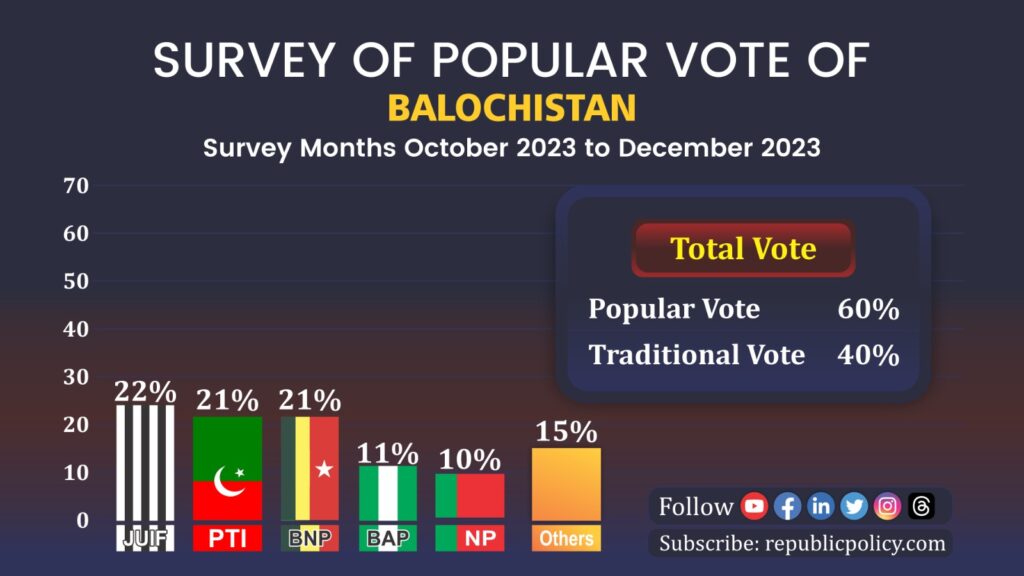
Republic Policy has conducted a survey of Balochistan province to gauge the sentiment of the populace regarding the upcoming general elections scheduled for February 8, 2024.
The survey reveals that Balochistan’s political landscape is characterized by a significant divide between popular vote and narrative, with 60 percent of votes driven by popular sentiment and 40 percent influenced by other factors.
Jamiat Ulema-e-Islam Emerges as Popular Choice:
According to the Republic Policy survey, Jamiat Ulema-e-Islam (JUI) leads as the most popular political party in Balochistan, commanding 22 percent of the popular vote. This underscores the party’s strong resonance with the electorate, likely driven by its ideological appeal and grassroots mobilization efforts.
Competitive Dynamics Among Major Players:
Both Pakistan Tehreek-e-Insaf (PTI) and Balochistan National Party (BNP) closely trail JUI with 21 percent popular vote support each. This indicates a competitive landscape where multiple parties vie for electoral supremacy, reflecting the diverse political preferences of Balochistan’s populace.
Other Key Players and Their Support Base:
Balochistan Awami Party (BAP) holds 11 percent public support based on popular vote, indicating a notable but comparatively lower level of backing. The National Party secures 10 percent public support, demonstrating its presence but with a smaller share of the electorate. Additionally, other political parties and members collectively garner 15 percent of the public support based on popular vote, showcasing a fragmented political landscape with various contenders vying for attention.
Overall, the survey sheds light on the nuanced political dynamics of Balochistan, where multiple parties compete for popular support amidst a backdrop of diverse interests and narratives. As the general elections approach, understanding these trends will be crucial for parties to formulate effective strategies and appeal to the electorate.
Republic Policy’s Survey Methodology: A Deeper Dive
Understanding public opinion and predicting political trends is crucial in a vibrant democracy like Pakistan. Republic Policy’s approach to this challenge focuses on constituency-level surveys, a departure from the usual national polls. This shift requires a closer look at our methodology to assess its strengths and limitations.
The Logic of Constituencies:
Pakistan’s parliamentary system hinges on winning seats in the National Assembly (NA), making constituencies the true battlegrounds. RP’s focus on individual constituencies instead of national popularity polls acknowledges this reality. Their central question – “Which political party will win how many seats among the 266 NA seats?” – aligns directly with the core dynamics of Pakistani politics.
Beyond “Who is Most Popular?”:
Presidential-style questions about the overall leader or party popularity, while relevant, are secondary in this context. Instead, RP delves deeper by analyzing how these national preferences translate into individual constituency preferences. This nuance is crucial, as local factors like clan affiliations and candidate personalities can sway voting patterns significantly.
Dissecting Constituencies:
Recognizing the inherent diversity within constituencies, RP utilizes Union Councils (UCs) as the basic unit for data collection. Each UC, with its unique mix of communities and political leanings, provides a more granular picture than a cumulative-level survey. This approach acknowledges that Pakistan’s or Punjab’s National Assembly constituencies comprising 20-40 UC constituencies, despite belonging to the same administrative unit, can harbor vastly different political landscapes.
Unpacking Voting Patterns:
Beyond party preference, RP’s Survey delves into the underlying reasons why people vote. Analyzing data through categories like age, profession, gender, and traditional affiliations (biradari/dhara) sheds light on the complex factors influencing voting decisions. This multi-faceted approach goes beyond the simplistic “popular vote” narrative and reveals the intricate tapestry of societal dynamics shaping political outcomes.
Simplicity and Refinement:
The Survey itself poses a single, straightforward question: “Which political party will you vote for?”. This clarity ensures ease of understanding and reduces potential confusion for respondents. However, further exploration into specific candidates, campaign promises, and local issues could provide even richer insights. It will be provided to the audiences when the candidates of the constituencies are declared by the political parties.
Transparency and Analysis:
While RP shares some conclusions drawn from their data, the details of their sampling methodology and data analysis remain useful for the people, political workers and parties. The political trends of constituencies covering all the Union councils, age groups, professions, and socio-political affiliations provide the surveys’ transparency, representativeness, and accuracy. Sharing information with the audiences about sample size, feedback, response rates, and statistical techniques provides credibility to the findings.
Additional Considerations:
The role of social media, particularly TikTok’s growing influence in rural areas, warrants further investigation in future surveys. Additionally, a more comprehensive analysis of the relative weight of factors like party, candidate, campaign, and polling day management in determining electoral outcomes would offer a more holistic understanding of Pakistani politics. The Republic Policy survey, extended for more than two months, has tried to measure the political affiliations of the different parts of the country to provide feedback to the political parties to make political decisions.
Conclusion:
Republic Policy’s constituency-based survey approach offers a valuable lens through which to understand political trends in Pakistan. Then we also believe that we have our own limitations as an organization. The funds, the untrained human capital, the passive response from the people, and many other factors limit our Survey. More than that, the surveys are always limited. They only provide data to make decisions. The election surveys are also a method to measure political trends and provide data to make decisions. Accordingly, the polling day result is the final outcome of the elections, and political parties must work until elections are polled.
However, addressing the identified weaknesses and incorporating additional considerations can strengthen the methodology and provide a more accurate and insightful picture of the electoral landscape. By adopting a transparent and comprehensive approach, RP is trying to contribute significantly to informed public discourse and democratic processes in Pakistan.
Lastly, data collection and analysis are critical for a research organization that works for governance, civil services, human rights, federalism, devolution and reforms. RP, with other partners, is striving for data collection in Pakistan to research the organization’s objectives. Pl visit republicpolicy.com and the organization page for details.
Please, subscribe to the YouTube channel of republicpolicy.com for detailed analysis on the survey.



































